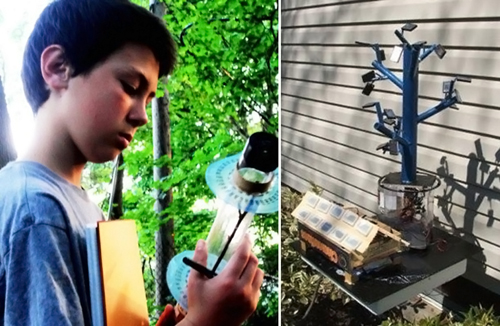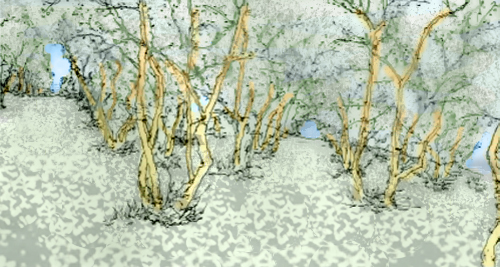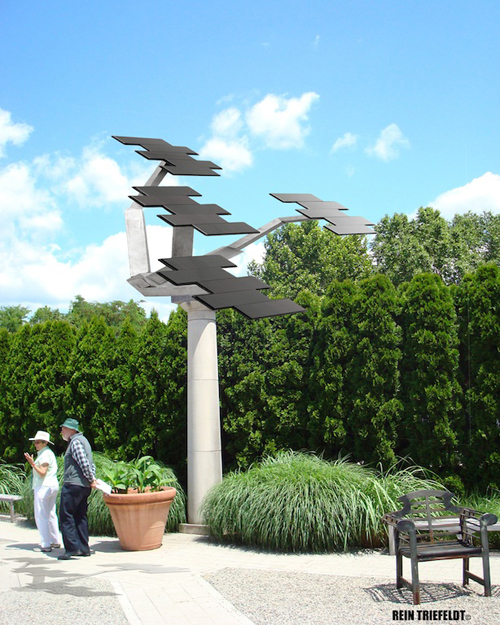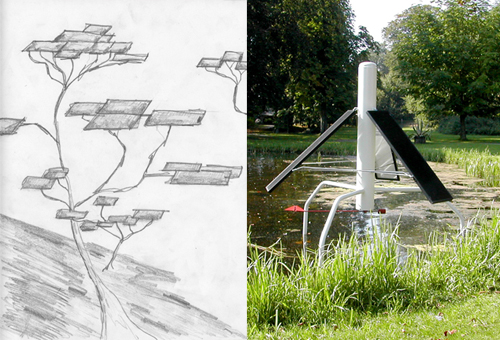Aidan Dwyer’s Fibonacci Solar Geometry

Aidan Dwyer, a 13 year old Long Island resident, has made some big news this week with his astute observations and experiments on solar power efficiency. While spending time in the woods, Aidan noticed that the trees branch out in a pattern that, when simplified, resembles a Fibonacci series spiral. Familiar with the concept of biomimetics in design, he wondered if the geometry that the trees have evolved for maximizing the efficiency of their solar reception might be applicable to solar efficiency of photovoltaic panels.
His study, which showed an increase in efficiency with the biomemetic design over a flat geometry, has earned him a provisional US patent according to the articles.
According to TreeHugger:
Summing up his research and imagining the possibilities, Aidan wrote: “The tree design takes up less room than flat-panel arrays and works in spots that don’t have a full southern view. It collects more sunlight in winter. Shade and bad weather like snow don’t hurt it because the panels are not flat. It even looks nicer because it looks like a tree. A design like this may work better in urban areas where space and direct sunlight can be hard to find.”
We hope that Aidan will be interested in applying his ideas to the 2012 Land Art Generator Initiative design competition for New York City!
story and images via Northport Patch, TreeHugger, and Inhabitat
Update 1: We stumbled upon this interesting post from the Department of Mathematics at the University of Surrey, UK. There are some links there to some great diagrams which give further evidence to this principle.
Update 2: Atlantic Wire has posted about a debunking of the claims in the media’s reporting on the project. It does rightly point out the sometimes less-than-critical nature of reporting on such things, but we don’t really see the harm in sensationalizing to some extent if it grabs attention and gets people thinking about the subject. In terms of the practical application of Fibonacci series placement of panels, it still may be true that if they are all optimally aligned to the sun there may be some benefit (think of the sunflower diagram with the entire thing pointed at 45 degrees and south, or the entire thing tracking the sun’s movement).
Rein Triefeldt’s Solar Tree Foundation
The story reminds of Rein Triefeldt‘s Solar Tree Foundation project, which we learned about through Solar Artworks.
Rein Triefeld is bringing science education to people through his kinetic art. He has been using solar power to bring motion to his kinetic artworks since at least 2002.
And from a bLAGI post in 2009, which was about SMIT‘s Solar Ivy:

I have long thought about how beautiful an orchard of 100 (10×10) trees with tiny PV leaves would be. The most beautiful place I can imagine to sit and contemplate is on the grass in the middle of an orchard. The sun makes such a beautiful tapestry of shadow on the ground and the multi-point perspective that the grid of trees constructs is ever-changing as you walk within. My personal favorite is an olive tree orchard with its tiny silvery leaves. Just imagine sitting in the midst of all that beauty while knowing that it is generating electricity. I figure an orchard that size would be enough to run more than a dozen homes. The above sketch is from an olive orchard on the Northern outskirts of Florence.
Related Posts
2 Comments
Add comment Cancel reply
This site uses Akismet to reduce spam. Learn how your comment data is processed.



[…] written about Fibonacci Series before here on bLAGI. So it does not come as a great surprise to us that the layout of heliostats […]
Sadly, Aidan is wrong. His experiment is flawed in multiple ways and the results are incorrect: Optimal angle is mathematically impossible to improve upon, Aidan was measuring voltage which doesn’t measure power generated, etc. However, kudos to Aidan for being the only human being “thinking” out of hundreds of others who just go along with whatever sounds good. For a complete breakdown of the problems with Aidan’s findings go here: http://optimiskeptic.com/2011/08/21/this-is-where-bad-science-starts/